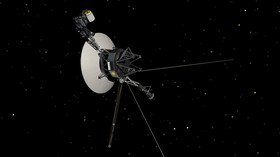Voyager 2 becomes second man-made object to enter interstellar space - NASA

NASA’s Voyager 2 probe has left the solar system and entered interstellar space, making history for being only the second man-made object to ever do so.
Voyager 2 exited the heliosphere – the protective bubble of particles and magnetic fields created by the Sun – on November 5, scientists have determined after studying data from instruments on board.
For the second time in history, a human-made object has reached the space between the stars. Now slightly more than 11 billion miles (18 bil. km) from Earth, @NASAVoyager 2 has now left the Sun's protective bubble & is flying in interstellar space: https://t.co/zRnhiaJqGS#AGU18pic.twitter.com/Zzncki4GKB
— NASA (@NASA) December 10, 2018
It is currently estimated to be over 11 billion miles from Earth, and the Voyager 2 team are still able to communicate with it, although it takes about 16.5 hours for information to travel from the spacecraft back to Earth.
Grand Tour Encore: Voyager 2, the only spacecraft to have visited Jupiter, Saturn, Uranus and Neptune, has left the Sun's bubble and joined me in interstellar space! https://t.co/2H9qMzogNYpic.twitter.com/dmDdNfbjLp
— NASA Voyager (@NASAVoyager) December 10, 2018
NASA will detail their findings at a news conference at 11 am EST (8 am PST) today at the meeting of the American Geophysical Union (AGU) in Washington.
The spacecraft’s Plasma Science Experiment (PLS) instrument provided NASA with key data that confirmed it has crossed the threshold of the heliopause, where hot solar wind meets cold and dense interstellar medium. It detected a sharp fall in the speed of solar wind particles and hasn’t picked up any solar wind flow since.
Although Voyager 1 crossed the same threshold in 2012, it did so without the PLS.
Voyager 2 is carrying other important instruments that can conduct groundbreaking observations into this border and beyond.
Also on rt.com Stranded in space, Iron Man? Roscosmos is coming to rescue you!The spacecraft left Earth in 1977 on a mission to study the outer planets, including Jupiter and Neptune. Since completing this initial mission, it has been studying the outer reaches of our solar system.
The device is expected to continue to transmit radio signals as it explores interstellar space until 2025.
Think your friends would be interested? Share this story!












